Sources of EMF and current: main characteristics and differences
 Electrical engineering relates the nature of electricity to the structure of matter and explains it by the movement of free charged particles under the influence of an energy field.
Electrical engineering relates the nature of electricity to the structure of matter and explains it by the movement of free charged particles under the influence of an energy field.
In order for electric current to flow through the circuit and work, there needs to be a source of energy to be converted into electricity:
-
mechanical energy of rotation of generator rotors;
-
the course of chemical processes or reactions in galvanic devices and batteries;
-
heat in thermostats;
-
magnetic fields in magnetohydrodynamic generators;
-
light energy in photocells.
They all have different characteristics. In order to classify and describe their parameters, a conditional theoretical division of sources is adopted:
-
current;
-
EMF.
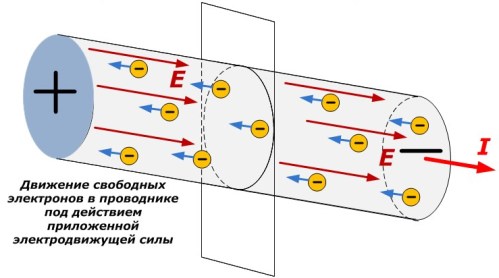
Electric current in a metal conductor
Definition amperage and the electromotive force in the 18th century was given by famous physicists of the time.
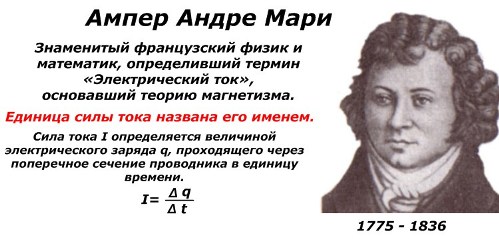

Source of EMF
An ideal source is considered to be bipolar, at the terminals of which the electromotive force (and voltage) is always maintained at a constant value.This is not affected by network load and internal resistance at the source is zero.
In the diagrams, it is usually indicated by a circle with the letter «E» and an arrow inside, indicating the positive direction of the EMF (in the direction of increasing the internal potential of the source).
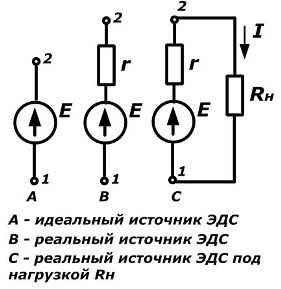
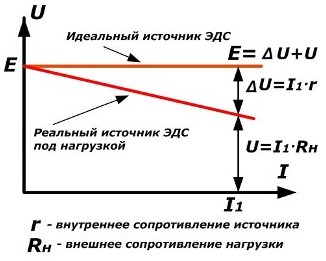
Designation schemes and current-voltage characteristics of EMF sources
Theoretically, at the terminals of an ideal source, the voltage does not depend on the magnitude of the load current and is a constant value. However, this is a conditional abstraction that cannot be applied in practice. For a real source, as the load current increases, the value of the terminal voltage always decreases.
The graph shows that the EMF E consists of the sum of the voltage drop across the internal resistance of the source and the load.
In fact, various chemical and galvanic cells, storage batteries, electrical networks work as voltage sources. They are divided into sources:
-
DC and AC voltage;
-
controlled by voltage or current.
Current sources
They are called two-terminal devices, which create a current that is strictly constant and does not depend in any way on the resistance value of the connected load, and its internal resistance approaches infinity. This is also a theoretical assumption that cannot be achieved in practice.
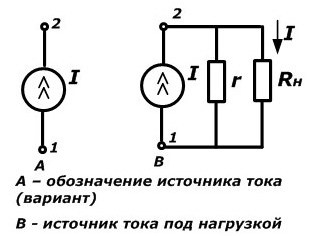
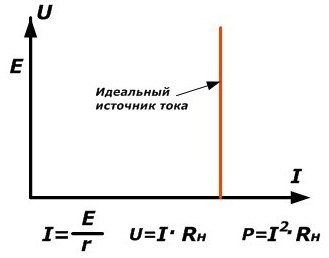
Designation schemes and current-voltage characteristic of the current source
For an ideal current source, its terminal voltage and power depend only on the resistance of the connected external circuit. Moreover, with increasing resistance, they increase.
The actual current source differs from the ideal value of the internal resistance.
Examples of a power source include:
-
Secondary windings of current transformers connected to the primary load circuit with its own supply winding. All secondary circuits operate in reliable connection mode. You can not open them - otherwise there will be surges in the circuit.
-
Inductors, through which the current has passed some time after the power has been removed from the circuit. Rapid switching off of the inductive load (a sudden increase in resistance) can cause the gap to break.
-
Current generator mounted on bipolar transistors, controlled by voltage or current.
In different literature, current and voltage sources may be designated differently.
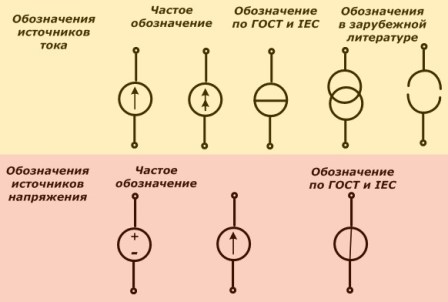
Types of designations for current and voltage sources on diagrams
Also read on this topic: External characteristics of the EMF source
